‘Behemoth’ is a word which springs to mind or, perhaps more nautically, ‘leviathan’.

Hanse Yacht’s latest, the new Hanse 460, shows off the work of a new design team that’s dead-set on giving today’s cruising sailors even more of what they want.
The first thing you notice about the Hanse 460 is its shape. It looks more rounded than the old model, has a chine forward above the waterline which disappears amidships, and a strong turn to the hull aft, like a rounded soft chine. The yacht is beamy and carries her beam aft, with a slight reverse to the bow.
This is certainly different – the result of Hanse taking the risky move of using new marine architects, French yacht designers Berret-Racoupeau.
So, what prompted the move? Speaking to Cameron Burch, sales manager for the Local Hanse agency Windcraft New Zealand, the change was the result of a competitive bid process. Hanse were looking for innovation and a yacht that would lead its market segment.

The risk paid off – the Hanse 460 won European Yacht of the Year as the best Family Cruiser for 2022, and according to Burch, delivered the most successful new product launch in Hanse’s long history of manufacturing cruising yachts.
I was keen to see what this new design offered and how she performed.
Our review was a mild winter day – a mixture of sunshine and a building southwest breeze, so perfect for sailing and getting action photos.
We met up with Code at Westhaven Marina and skipper David Irwin, one of the yacht’s joint owners. The other owner, David’s friend Mark McManus, wasn’t available to join us.
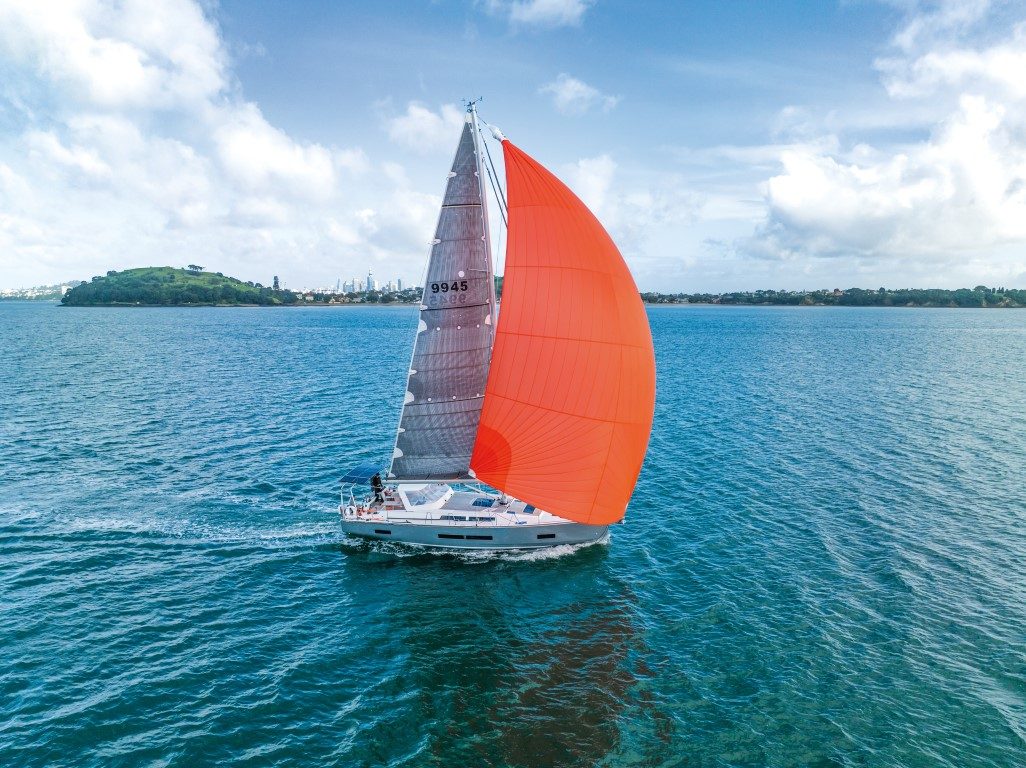
David and Mark were looking for a cruising yacht that’s easy for a couple to sail, but also large enough for two couples to sail together. They are planning cruises to Fiji and around New Zealand.
Initially they looked at second-hand yachts but found nothing suitable. That left new yachts and the new Hanse 460 was fresh on the drawing board. They took delivery late 2022 and – apart from an initial cruise over summer – they have been busy setting the boat up for offshore.
Impressions
Stepping aboard via the wide drop-down transom, I was greeted by a huge cockpit: twin helm stations with part-carbon wheels and twin pedestal tables which drop down to seat level making wide sun loungers or extra cockpit berths.
The rear platform lowers via a purchased pulley onto a fixed length strop, making alighting easy. The cockpit seats fold up out of the way for egress onto the marina, as well as giving access to the large aft lockers under the cockpit floor, the starboard locker housing the life raft.
Sailing controls lead aft to a bank of jammers on both sides, a pair of Lewmar electric winches, plus a second manual winch on the coamings aft.

The twin pedestal steering stations sport full B&G instrumentation, with a large MFD, compass and switches.
A key element of the cockpit is the rear arch. This supports solar panels and acts as a dinghy davit. It is also the attachment point for an infill bimini to cover the cockpit. Clearly a lot of thought had gone into it.
Solar power is a key for cruising and the rear arch holds 800-watt solar panels providing nearly 40 amps of power at peak output. The arch’s extendable arms take the load of the dinghy and lift it out of the water. For longer passages the dinghy fits neatly upside down on the foredeck.
The solar panels feed 800AH (amp-hour) lithium batteries, along with two 100-amp alternators run off the 80hp Yanmar diesel. A 3000-watt inverter provides 240-volt power.
David clearly understands that setting up a comfortable cockpit with shelter from the elements, and having onboard systems with plenty of power, makes for pleasant cruising.
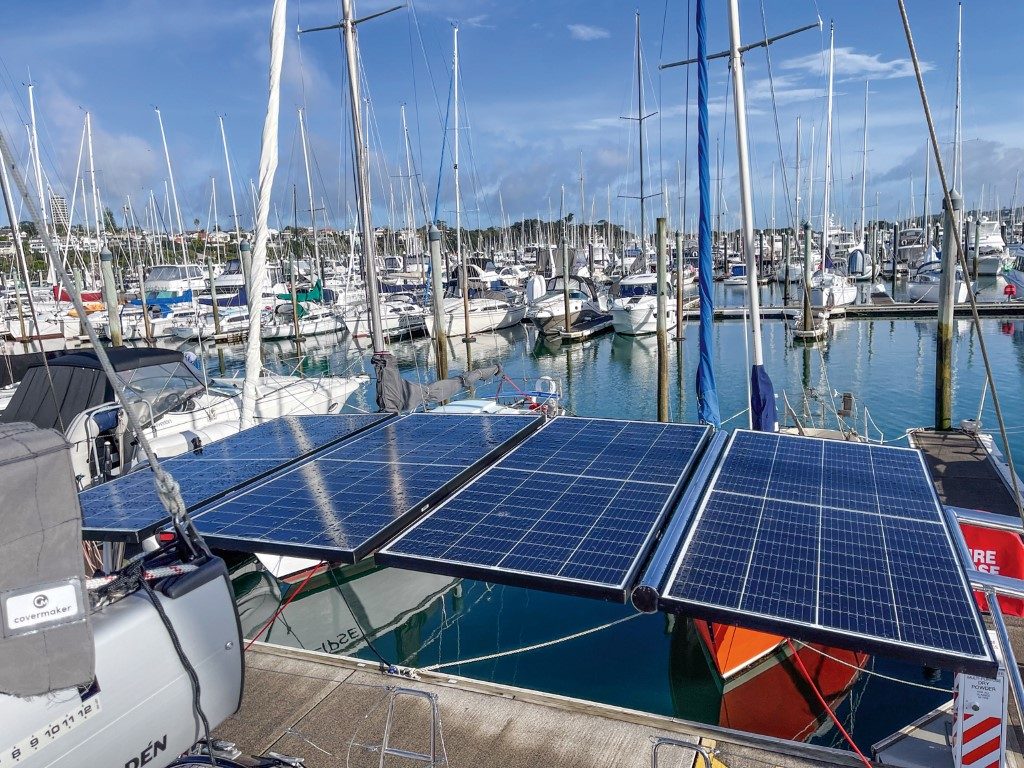
Side decks are generous in width with a pronounced stipple for good grip and there is a nice-sized bulwark moulded in. Fittings all look robust and collapsing mooring cleats are a nice touch.
Layout
Code has three cabins, the master cabin forward and twin double quarter berths. Down the companionway and to starboard is a well set up navigation station in an L shape with a B&G display, VHF radio, stereo and gas detector. Directly above is the switch panels, both manual and electronic system monitoring.
The L-shaped galley is forward to starboard, giving good benchtop space. There is an ENO cooker with oven set under a lifting bench cover and an Isotherm fridge. The galley has large drawers and cupboards, as well as overhead lockers for plenty of storage. Hull windows illuminate the benchtop with natural light.

Directly behind the galley is a central island which acts as a brace for the cook in a seaway and a seat back for the dining table, which is set forward to port surrounded by comfortable seating for six. A shelf above the seats, for books or other objects, is a nice, homely touch. Hull windows at eye level when seated provide a nice view out. A lowering pedestal table option provides another berth if required.
Code has a bright interior with plenty of natural light – joinery and panelling in French oak, along with oak flooring, bring a lovely ambience to the cabin.
A good-size head and shower – readily accessible from the cockpit – can be found aft of the dining area on the port side, while aft of the navigation station there’s space for another head. However, on Code it is set up with a small workbench and storage, as well as a 70-litre freezer-drawer. David’s reckons two bathrooms are plenty – working space for maintenance tasks that always arise when cruising is more important.
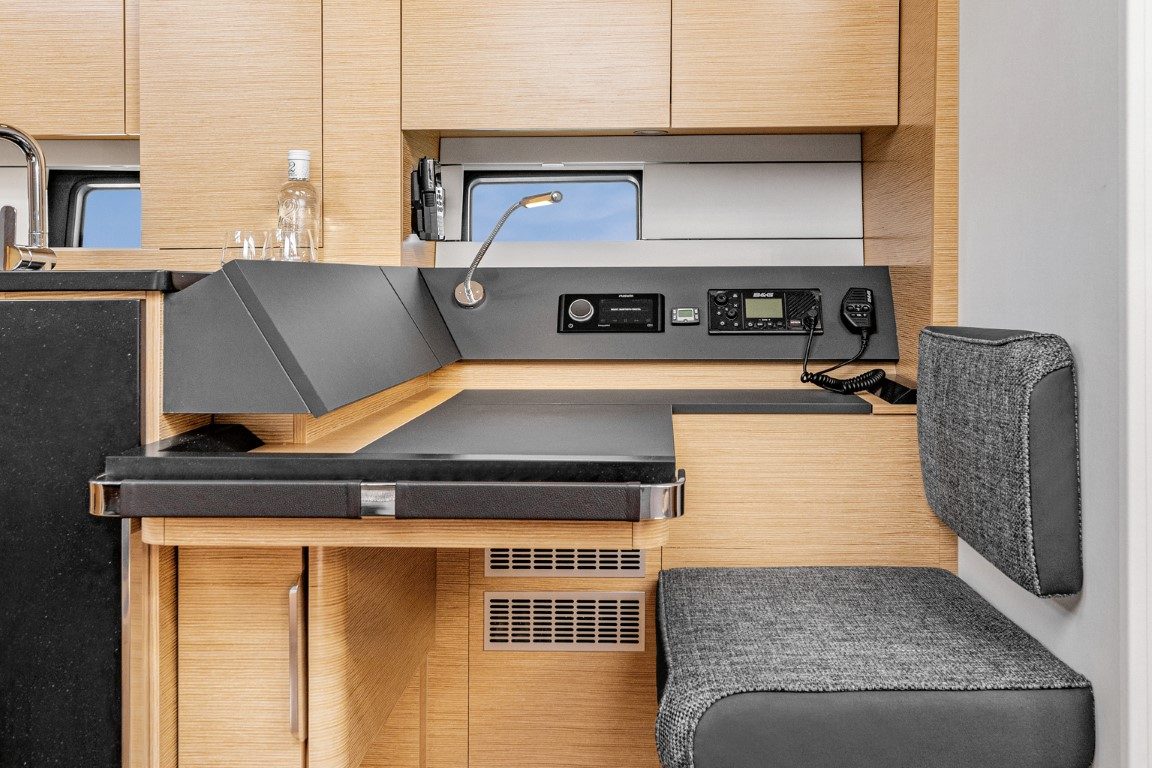
Quarterberth
The starboard quarter-berth is a little different. David showed me how it was set up with a proprietary box storage system, screwed down to the bunk base, two storage boxes high. The top box is securely fastened to the box below but relatively easily removed to allow access to stored items.
This would be very useful for long-term cruising, as the amount of gear you require quickly adds up. When properly catalogued, it should be easy to find that elusive sail repair kit, or replacement water filter cartridge.
This arrangement does result in the loss of one bunk space, but when extended cruising is over, it can be easily converted back to a double berth.
The starboard quarter-berth is a full double with storage on the side as well as a hull window.
The engine is an 80hp Yanmar diesel with saildrive, easily accessible under the companionway steps. This is an upgrade from the standard 57hp model.
Forward berth
The forward cabin has a large double berth partly accessible around the sides, with a small step up. It’s a lovely light-filled cabin thanks to hull windows and two overhead hatches. The ensuite on the port side and includes a toilet, vanity and separate shower. Hanse offers different options for additional storage and/or seating – on Code they have chosen a seat to starboard with hanging lockers either side.
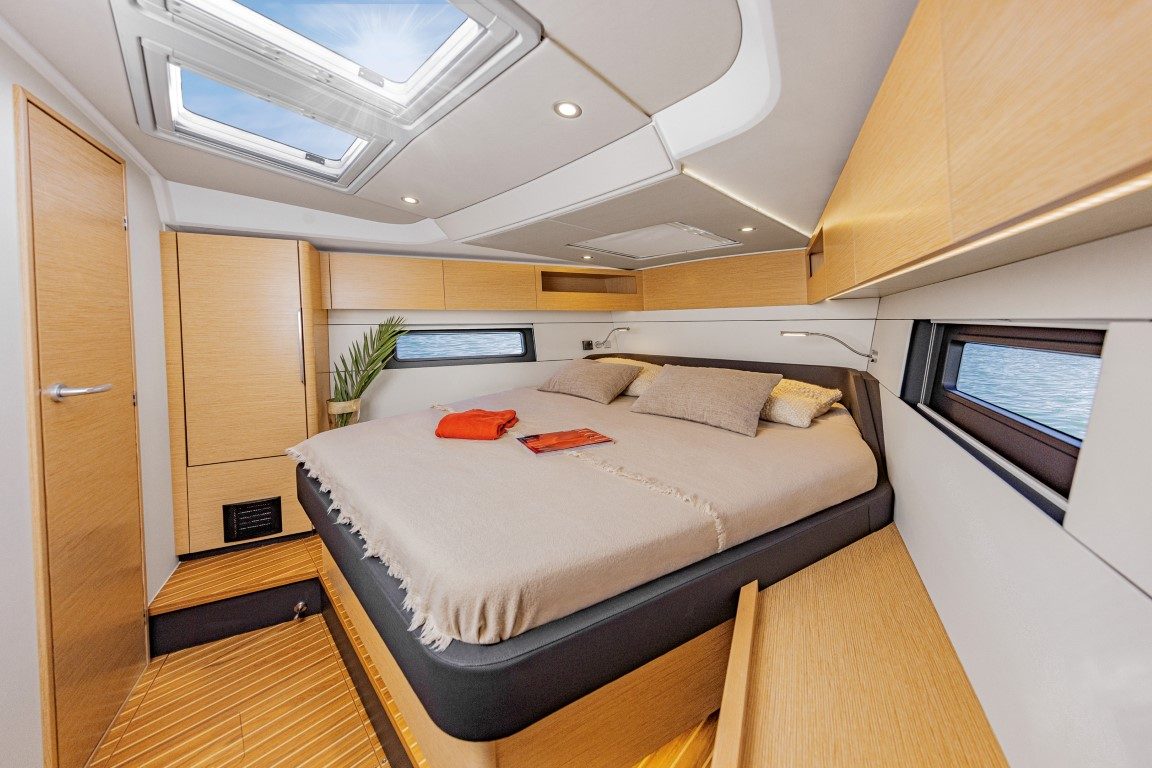
There is ample headroom throughout the boat – more than enough for my 6’ 5” (1.96m) frame with room to spare.
Sailing
Our plan for the day was to sail the yacht two-handed, while I followed in the chase boat with the camera and drone. We would then stop off Cheltenham Beach so I could transfer aboard to sail her back.
The Hanse 460 comes with a Selden rig. She has twin furling headsails, the inner being a smaller self-tacking headsail and the larger an overlapping genoa. They are controlled by lines back to the cockpit.

The mainsail is fully battened on ball bearing cars for easy raising and lowering. All halyard controls are led aft through covered slots. The mainsail sheeting is a continuous sheet with the boom centrally sheeted on the cabin top.
The beautifully shaped sails for Code are made locally by Evolution sails in high quality carbon membrane material – and they really did look a treat!
Motoring out of Westhaven, Code looked great with her custom dark-grey hull contrasting nicely with the white cabin top in the morning sun. Sails raised and Code was soon reaching nicely past the wharves under her larger headsail. Her reverse bow looks purposeful while the forward hull chine breaks up the high topsides nicely. It’s a good way to get some more internal volume as well as stiffen up the hull forward.
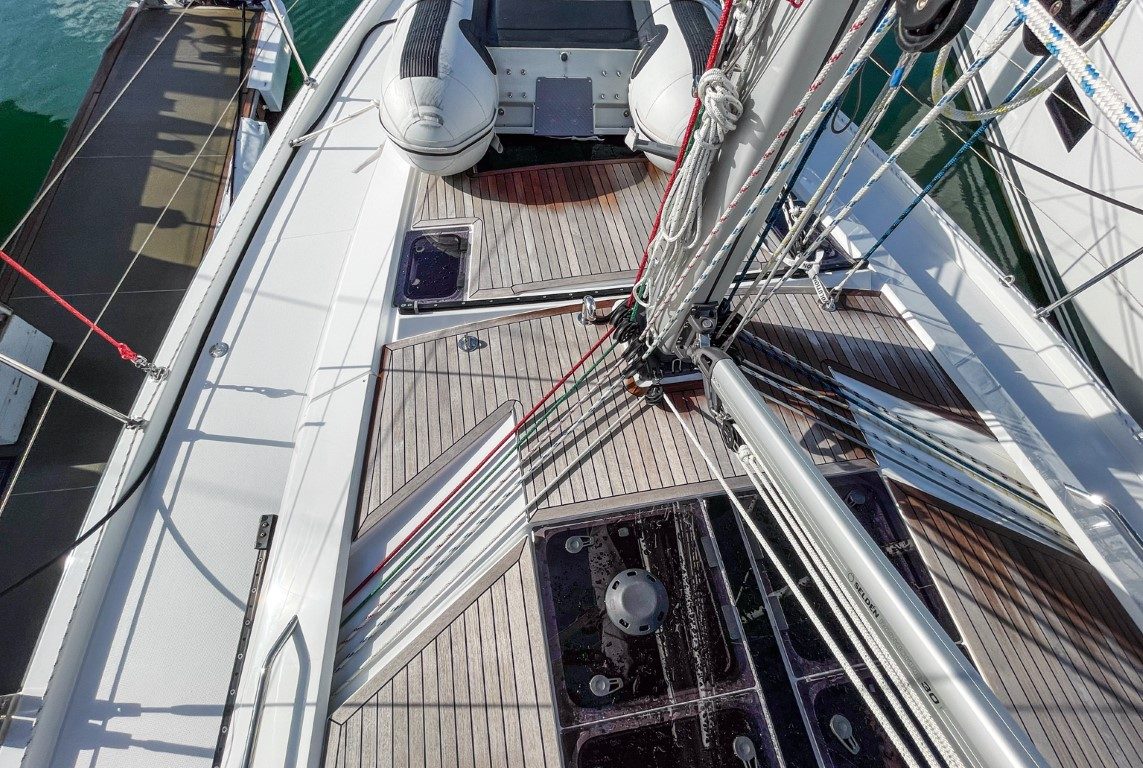
Out past Bean Rock, Cameron quickly sorted out the right halyard and sheets for the socked A2 (asymmetrical spinnaker) and Code was reaching beautifully heading down the Rangitoto Channel.
The A2 is a great cruising sail, giving a real boost to boat speed in lighter winds. It’s ideal for two-handed sailing as well, particularly with the sock to douse it easily if the wind gets up a bit. Cameron reported that in 10-12 knots true they were seeing 7- 9.5 knots STW (speed through water). It certainly looked smooth and effortless, with the yacht moving nicely.
With the gennaker down and the large headsail rolled out, Code headed back upwind towards Cheltenham Beach so I could go aboard and take my turn at the helm.
The forward stem fitting provides a solid platform for dropping the anchor, ensuring it is clear of the bow and the large locker directly aft of the anchor winch has plenty of room for extra warps and fenders.
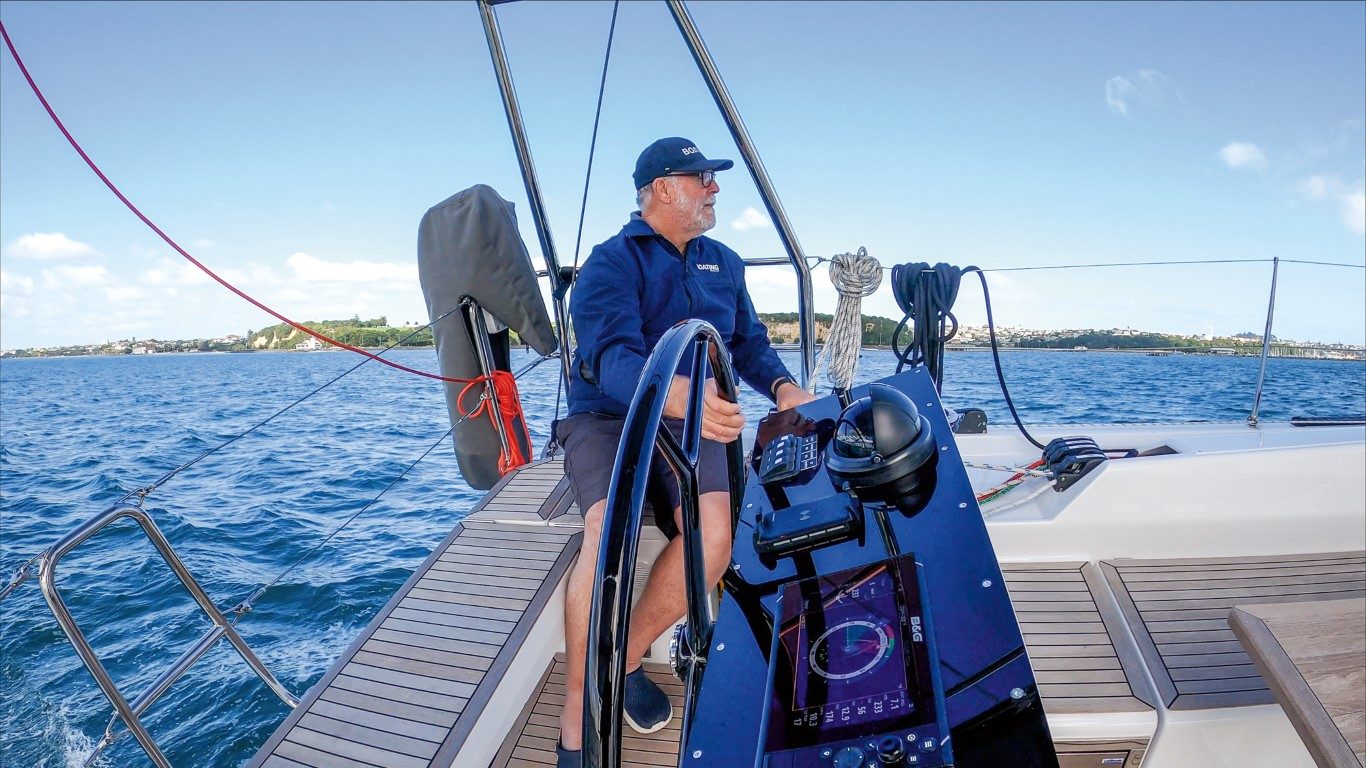
The wind had increased nicely so after weighing anchor and raising the main under the shelter of North Head, we rolled out the small self-tacking jib and came hard on. She felt nicely powered up with a true wind speed (TWS) of about 17 knots. The single balanced rudder was giving me good feedback, with a nice bit of weather helm. We sat close to seven knots as I kept her in the groove. Tacking was a doddle – nothing to do except turn the wheel and swap sides.
I found the right helming position sitting on the windward sidedeck with good sight lines and views of the instruments – there was a nice small B&G instrument repeater on the side of the pedestal instruments giving me boat speed and wind data.
The wind was fresh enough to get Code heeling and sitting nicely on her wide, rounded hull – a good angle to sail upwind for the first few days when coming home from Fiji.
The mainsail has slab reefing controlled from the cockpit – not having to venture on deck in the rough is great for safety, but also great for getting a good sail shape in the strong wind.
The backstay is split, running to each quarter, the tension adjustable using a neat winch handle operated mechanism on the starboard side.
Up near the container terminal, we swapped to the big headsail and eased off towards Bayswater, getting 8.1 knots with a TWS of 15.8 knots and 8.4 with 17.9 knots. But all too soon we had run out of water – it was time to head back to the dock.

The engine controls are easily accessible beside the wheel on the side of the cockpit and the motor easily pushed us up through the building chop. We backed into our marina berth with quite a side wind using the bow thruster to hold her straight.
Overall
Hanse have certainly upped their game with the new 460. The new, more rounded look appeals, there are numerous incremental improvements, and more internal space – and the new model retains Hanse’s famous performance and ease of handling.
I like the fact that even with such a wide hull Hanse has retained a single rudder design – to me it signifies the designers know when to push the boundaries and when to pull back. They understand their intended market.
The 460’s design language is now being rolled out through Hanse’s yacht range, with the 510 released late last year to similar acclaim and a new 410 also now available, all with layout options to suit a variety of cruising needs.
Hanse has produced another stunning performance cruising yacht in the new 460. With Code set up for offshore with her custom-made bimini arch and electrical system, I’m sure she will provide her owners with a safe, comfortable and well performing yacht for many years.
/>
‘Behemoth’ is a word which springs to mind or, perhaps more nautically, ‘leviathan’.
White Pointer has earned the respect of discerning customers in New Zealand and Australia, attracting a loyal and ever growing following for its high-quality, rugged and totally dependable aluminium trailer boats.
The hardtop SP635 shares the same underpinnings as the popular SF 635 which was a completely new model back in 2020.
The pride and joy of a multi-generational family, Bliss resides on a pier that’s home to a couple of other Elite motor launches – Sandspit Marina is a hot-spot for the Bill Upfold-designed vessels, with several calling this small marina home.